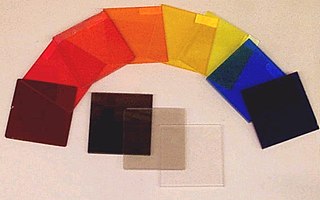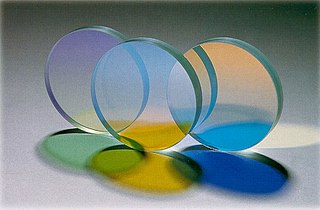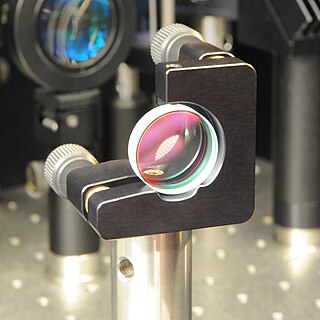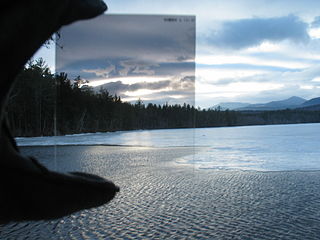 W
WAn optical filter is a device that selectively transmits light of different wavelengths, usually implemented as a glass plane or plastic device in the optical path, which are either dyed in the bulk or have interference coatings. The optical properties of filters are completely described by their frequency response, which specifies how the magnitude and phase of each frequency component of an incoming signal is modified by the filter.
 W
WAn astronomical filter is a telescope accessory consisting of an optical filter used by amateur astronomers to simply improve the details of celestial objects, either for viewing or for photography. Research astronomers, on the other hand, use various band-pass filters for photometry on telescopes, in order to obtain measurements which reveal objects' astrophysical properties, such as stellar classification and placement of a celestial body on its Wien curve.
 W
WAn atomic line filter (ALF) is a more effective optical band-pass filter used in the physical sciences for filtering electromagnetic radiation with precision, accuracy, and minimal signal strength loss. Atomic line filters work via the absorption or resonance lines of atomic vapors and so may also be designated an atomic resonance filter (ARF).
 W
WIn signal processing, a band-stop filter or band-rejection filter is a filter that passes most frequencies unaltered, but attenuates those in a specific range to very low levels. It is the opposite of a band-pass filter. A notch filter is a band-stop filter with a narrow stopband.
 W
WCokin is a French manufacturer of optical filters for photography. The system allows filters such as rectangular graduated neutral density filters which are versatile in use.
 W
WA color gel or color filter, also known as lighting gel or simply gel, is a transparent colored material that is used in theater, event production, photography, videography and cinematography to color light and for color correction. Modern gels are thin sheets of polycarbonate, polyester or other heat-resistant plastics, placed in front of a lighting fixture in the path of the beam.
 W
WA color wheel or other switch for changing a projected hue is a device that uses different optics filters within a light beam. Common usage includes continuously-rotating wheels for seasonal home displays and controllable color wheels for a particular instrument, while non-wheel devices include scrollers and semaphore types with lever arms.
 W
WA dichroic filter, thin-film filter, or interference filter is a color filter used to selectively pass light of a small range of colors while reflecting other colors. By comparison, dichroic mirrors and dichroic reflectors tend to be characterized by the colors of light that they reflect, rather than the colors they pass.
 W
WA dielectric mirror, also known as a Bragg mirror, is a type of mirror composed of multiple thin layers of dielectric material, typically deposited on a substrate of glass or some other optical material. By careful choice of the type and thickness of the dielectric layers, one can design an optical coating with specified reflectivity at different wavelengths of light. Dielectric mirrors are also used to produce ultra-high reflectivity mirrors: values of 99.999% or better over a narrow range of wavelengths can be produced using special techniques. Alternatively, they can be made to reflect a broad spectrum of light, such as the entire visible range or the spectrum of the Ti-sapphire laser. Mirrors of this type are very common in optics experiments, due to improved techniques that allow inexpensive manufacture of high-quality mirrors. Examples of their applications include laser cavity end mirrors, hot and cold mirrors, thin-film beamsplitters, high damage threshold mirrors, and the coatings on modern mirrorshades.
 W
WEnChroma lenses are glasses which are designed to alleviate symptoms of red–green color blindness. Studies have shown that while the lenses alter the perception of already perceived colors, they do not restore normal color vision. Initial claims in excess of this by the manufacturer have been criticised and characterized as marketing hype. Recent research has shown the lenses have a positive impact on those with red-green color blindness.
 W
WA graduated neutral-density filter, also known as a graduated ND filter, split neutral-density filter, or just a graduated filter, is an optical filter that has a variable light transmission. Typically half of the filter is of neutral density which transitions, either abruptly or gradually, into the other half which is clear. It is used to bring an overly-bright part of a scene into the dynamic range of film or sensor. For example, it can be used to darken a bright sky so that both the sky and subject can be properly exposed. ND filters can come in a variety of shapes and sizes and densities and can be used in all types of photographic applications from still photography, motion photography and scientific applications.
 W
WH-alpha (Hα) is a specific deep-red visible spectral line in the Balmer series with a wavelength of 656.28 nm in air; it occurs when a hydrogen electron falls from its third to second lowest energy level. H-alpha light is the brightest hydrogen line in the visible spectral range. It is important to astronomers as it is emitted by many emission nebulae and can be used to observe features in the Sun's atmosphere, including solar prominences and the chromosphere.
 W
WInfrared cut-off filters, sometimes called IR filters or heat-absorbing filters, are designed to reflect or block near-infrared wavelengths while passing visible light. They are often used in devices with bright incandescent light bulbs to prevent unwanted heating. There are also filters which are used in solid state video cameras to block IR due to the high sensitivity of many camera sensors to near-infrared light. These filters typically have a blue hue to them as they also sometimes block some of the light from the longer red wavelengths.
 W
WAn interference filter or dichroic filter is an optical filter that reflects one or more spectral bands or lines and transmits others, while maintaining a nearly zero coefficient of absorption for all wavelengths of interest. An interference filter may be high-pass, low-pass, bandpass, or band-rejection.
 W
WA liquid crystal tunable filter (LCTF) is an optical filter that uses electronically controlled liquid crystal (LC) elements to transmit a selectable wavelength of light and exclude others. Often, the basic working principle is based on the Lyot filter but many other designs can be used. The main difference with the original Lyot filter is that the fixed wave plates are replaced by switchable liquid crystal wave plates.
 W
WIn photography and optics, a neutral-density filter, or ND filter, is a filter that reduces or modifies the intensity of all wavelengths, or colors, of light equally, giving no changes in hue of color rendition. It can be a colorless (clear) or grey filter, and is denoted by Wratten number 96. The purpose of a standard photographic neutral-density filter is to reduce the amount of light entering the lens. Doing so allows the photographer to select combinations of aperture, exposure time and sensor sensitivity that would otherwise produce overexposed pictures. This is done to achieve effects such as a shallower depth of field or motion blur of a subject in a wider range of situations and atmospheric conditions.
 W
WIn photography and cinematography, a filter is a camera accessory consisting of an optical filter that can be inserted into the optical path. The filter can be of a square or oblong shape and mounted in a holder accessory, or, more commonly, a glass or plastic disk in a metal or plastic ring frame, which can be screwed into the front of or clipped onto the camera lens.
 W
WA polarizing filter or polarising filter is often placed in front of the camera lens in photography in order to darken skies, manage reflections, or suppress glare from the surface of lakes or the sea. Since reflections tend to be at least partially linearly-polarized, a linear polarizer can be used to change the balance of the light in the photograph. The rotational orientation of the filter is adjusted for the preferred artistic effect. For modern cameras, a circular polarizer (CPL) is typically used; this comprises firstly a linear polarizer which performs the artistic function just described, followed by a quarter-wave plate which further transforms the now-linearly polarized light into circularly-polarized light before entering the camera. This additional step avoids problems with autofocus and light-metering sensors within some cameras, which otherwise may not function reliably with a simple linear polarizer.
 W
WIn solar thermal collectors, a selective surface or selective absorber is a means of increasing its operation temperature and/or efficiency. The selectivity is defined as the ratio of solar radiation absorption (αsol) to thermal infrared radiation emission (εtherm).
 W
WThe Tiffen Company is a company in Hauppauge, New York, U.S. which manufactures filters for photography, and other professional film and photography-related products. Founded in 1945, by Sol Tiffen who brought his brothers Leo and Nat into the business, the company has won several Academy Awards for technical achievements in filtration. Nat Tiffen, as well as Ira Tiffen, each won technical achievement awards.
 W
WUV filters are compounds, mixtures, or materials that block or absorb ultraviolet (UV) light. One of the major applications of UV filters is their use as sunscreens to protect skin from sunburn and other sun/UV related damage. After the invention of digital cameras changed the field of photography, UV filters have been used to coat glass discs fitted to camera lenses to protect hardware that is sensitive to UV light.
 W
WWratten numbers are a labeling system for optical filters, usually for photographic use comprising a number sometimes followed by a letter. The number denotes the color of the filter, but is arbitrary and does not encode any information ; letters almost always increase with increasing strength.